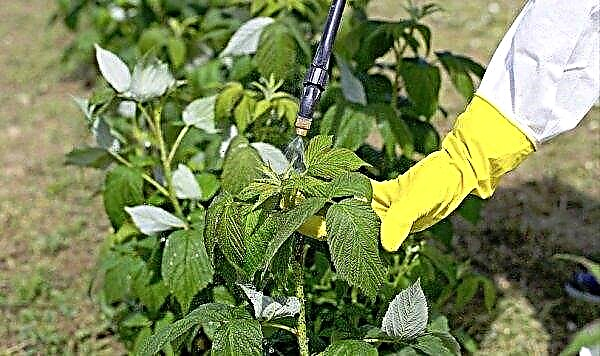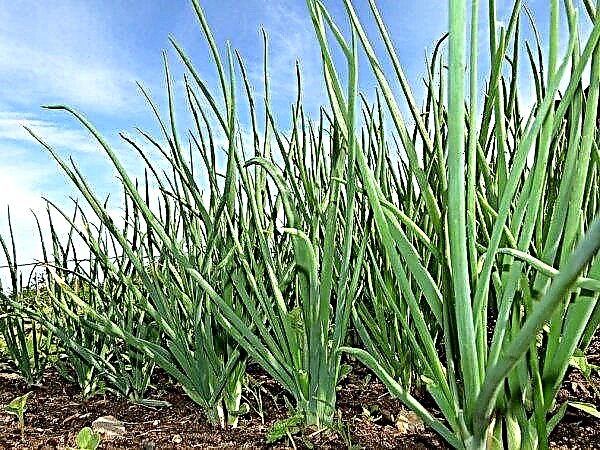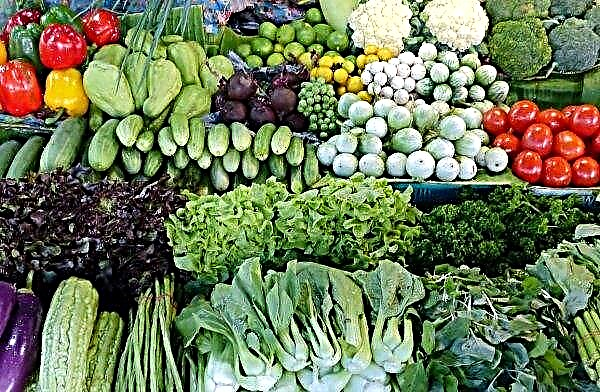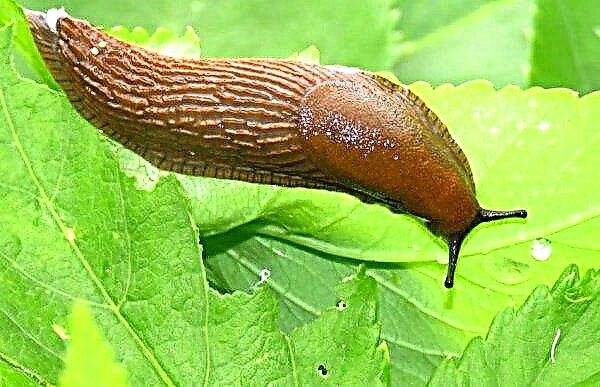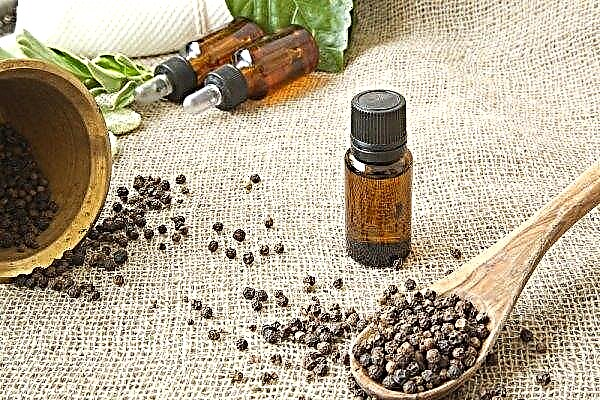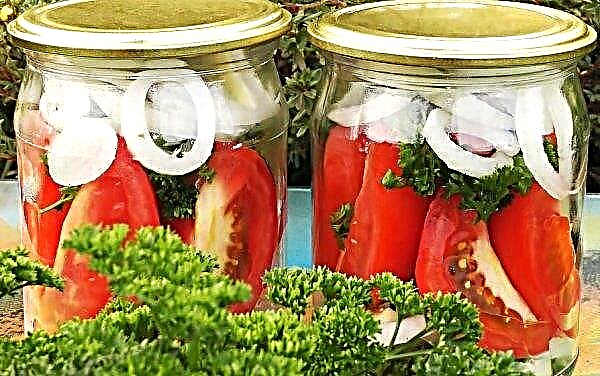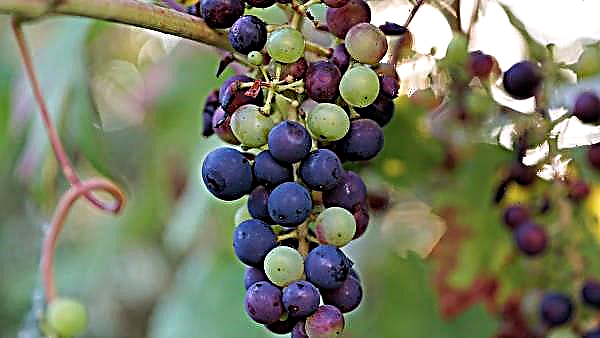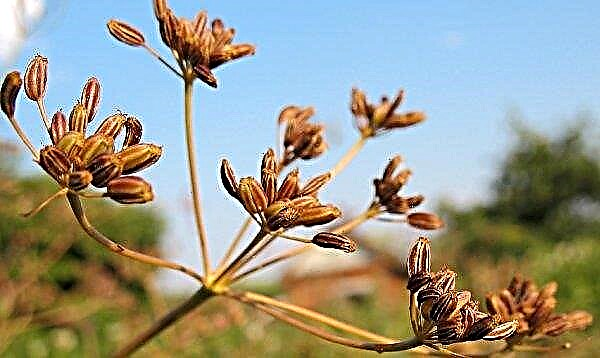Orange tomatoes contain more carotenoids than the usual red varieties. Tomato lovers are attracted by the cheerful color and sweet taste of such fruits. Let's get acquainted with the variety of tomatoes Orange, its pluses and minuses, as well as agricultural farming technology.
Description and characteristics of the variety
The tomato variety Orange has an average ripening period; under favorable conditions, its fruits can be enjoyed 100 days after emergence. This is a semi-determinant variety that forms non-standard bushes up to 1.5 m high and needs a garter. On flower brushes 3-5 fruits of orange color and round shape with an unexpressed ribbing are tied.
Did you know? Orange color improves appetite, improves mood and relieves depression. It gives a sense of celebration and sets up for positive emotions. These properties are used in the treatment of color therapy.
Their fleshy juicy pulp contains almost no seeds, has a sweetish taste. The sugar content of the pulp is 3.2%, the dry matter content is 6.2%. Tomatoes weigh an average of 200–250 g, but individual specimens gain about 400 g of weight. Inside there are 4 seed chambers.
This is a variety with an extended fruiting period; in protected ground it can bear fruit until November. Each bush per season can give 3.5-4 kg of fruit. In general, with good agricultural technology, you can get up to 20 kg from 1 m².
The variety is heat-loving and in the open ground can be grown only in the southern regions. In other regions, it is advisable to grow it in greenhouse conditions.
Advantages and disadvantages
- The advantages of the tomato variety Orange include the following:
- attractive appearance of fruits with unusual coloring;
- great taste;
- the ability to collect seed material for future use;
- dietary properties of fruits;
- resistance to common diseases for tomatoes;
- prolonged fruiting;
- high productivity.
- This tomato has the following disadvantages:
- the need for garter and herding;
- the fruits are poorly stored and transported;
- sensitivity to weather conditions - prefers heat.
How to grow tomato seedlings yourself
The tomato variety Orange is grown mainly in seedlings.
Sowing time
The sowing date depends on the climate of the region and the method of cultivation (in a greenhouse or open ground). Seedlings of this heat-loving variety should be planted when stable warm weather has come and the threat of frost has passed, and the soil temperature has warmed up to + 12 ° С. In the southern regions, this time may come in the 10th of April, in the Central Black Earth region - in the 10th of May, and in the middle lane - from June 10th. You can view historical temperature statistics for your places and select a suitable date.
Seedlings of mid-ripening tomato varieties are planted on beds 60–65 days old from emergence of seedlings. Taking into account the time for emergence of seedlings in 5–7 days with a countdown, it can be determined that for growing seedlings in open ground in the south, seeds of tomato cultivars Orange can be sown in early February, in the center of the Black Earth region at the very beginning of March, and for the middle lane - in early April. Since it makes sense to plant this variety in a greenhouse, the planting time can be accelerated by several weeks.
Soil mix
For seedlings, it is easiest to purchase ready-made soil at retail outlets. But if desired, the substrate can be made by yourself. It should be noted that it must be nutritious and well permeable, with an acidity in the range of 6.2–6.8 pH.
The soil mixture can be prepared as follows: mix 1 part of the earth from the beds on which solanaceous crops did not grow, 2 parts of non-acid peat, 1 part of humus and ½ part of sand. If peat is high acidity, then ash must be added to the mixture. It will be good to add a little superphosphate to this soil.Important! A homemade soil mixture should be decontaminated - hold in an oven, pour over boiling water or a solution of potassium permanganate.
Capacity for growing
You can use different containers for tomato seedlings:
- Boxes. Can be used many times, easy to move and transport. They save space on the window. Plants from them should be planted carefully so as not to damage the roots.
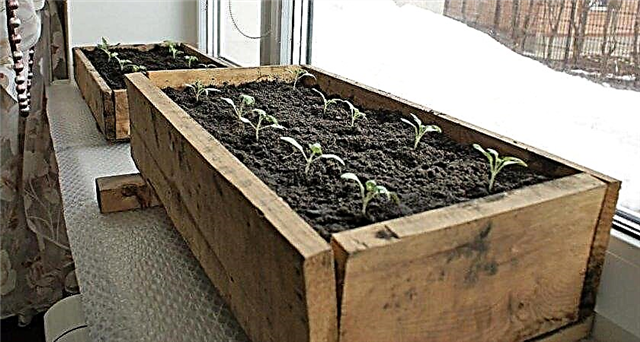
- Peat pills and glasses. In them, the root system of tomatoes feels most comfortable. They need moisture control because they dry out faster than other containers. They need a pallet and are expensive. Convenient for landing.
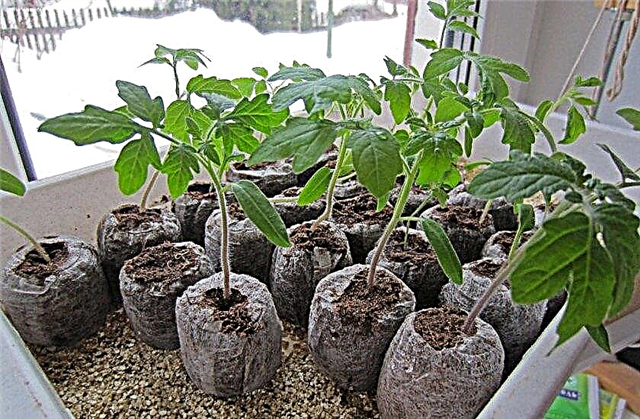
- Seedling pots. Reusable packaging, taking up a lot of space and poorly transported. When extracting a plant from it, care must be taken.

- Plastic cassettes. They require a pallet and caution when planting seedlings. Poorly transported.

- Disposable plastic dishes. It can be purchased or made independently from plastic bottles.
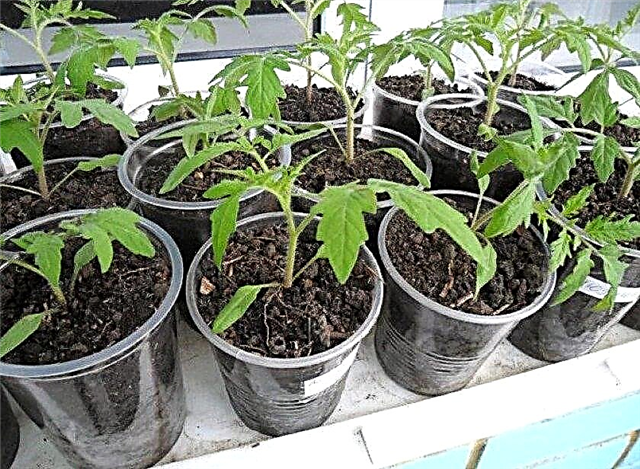
For tomatoes, select containers with a height of 10-17 cm and a volume of 1 liter. All must have drainage holes. If they are not, then they should be done by ourselves.
Seed preparation
It is recommended to calibrate your own seeds - immerse them in a salt solution for 10 minutes (1 tbsp. L. Salt per 1 l. Of water). Then remove the pop-up specimens, and use the seed that has sunk to the bottom for planting.
Seeds should be decontaminated before planting. Usually for this they are soaked for 15–20 minutes in a light solution of potassium permanganate (1 g per 100 ml of water). Then they need to be washed well and dried.
Seeds can be stimulated by growing by soaking for 12 hours in a solution of "Epina" or aloe juice diluted in water in a ratio of 1: 1.
Did you know? Tomatoes were brought to Eurasia from South America by the Spaniards in the 16th century. Their name comes from the Aztec word "tomato", which meant "large berry."
Sowing seeds
Before planting, the soil in the prepared dishes is moistened. In separate containers when growing seedlings without diving, they plant 1-2 seeds to a depth of about 1 cm.
In seedling containers for subsequent diving, grooves are made with a depth of 1 cm at a distance of 4 cm from each other. Treated seeds are placed in them with an interval of 1–2 cm.
Then the plantings are carefully sprinkled with earth, moisten again a little and cover with a film on top. The container with crops is transferred to a dark, warm (+ 25 ... + 30 ° С) place. Usually they are placed near a heating battery. Every day, planting a little air and control the moisture content of the soil.

Seedling Care
After the emergence of sprouts, planting must be transferred to the most illuminated window sill. Best of all, to the south. If there is a lack of light, additional illumination should be organized. The optimum temperatures for tomato seedlings are: daytime - + 18 ... + 25 ° С, night - + 12 ... + 15 ° С. In the first week after emergence, so that the sprouts do not stretch, they should be kept at a slightly cooler temperature.
Watering is necessary as needed. Do not allow the soil to dry out or flood it. Particularly dependent on moisturizing seedlings in the first week. Watering seedlings is best in the morning.
Diving seedlings in separate containers do in the phase of two real leaves.Seedlings for the entire period of its cultivation need additional nutrition. The first is done 2-3 weeks after the appearance of the sprouts, and the next every decade. For top dressing, it is best to use ready-made fertilizers (for example, "Agricola") or compounds based on humates, biohumus. Mullein solution can be used.
Seedling hardening
10-14 days before the planned planting, plants should be taken out onto a balcony or loggia for hardening. First, they are carried out in the warmest time of the day for several hours. Then this time is slightly increased daily. The day before planting, tomato seedlings should spend all day on the balcony.
Planting seedlings in a permanent place
Tomato seedlings should be properly planted in a permanent place.
The timing
Planting time for seedlings depends on weather and climate. The soil should warm up enough. Typically, planting time falls in the period from May to early June, but planted in protected ground 2-3 weeks earlier. In the southern regions, this time may be even earlier.
The average air temperature should be set at + 12 ... + 15 ° С, and the soil should be warmed up to + 12 ° С.
Seat selection
The landing site is selected and prepared in advance. First of all, it should be well-lit by the sun's rays, as all tomatoes without exception love light and heat. Groundwater level should not be too close to ground level - the root system of plants will rot.
A light soil with a neutral or slightly acidic reaction (6–6.5 pH) is well suited for growing tomatoes. Loams fed with fertilizers will be good.
Landing area prepared in the fall. It is dug up, the remains of vegetation are removed and fertilizers are applied. For this purpose, organics (dung humus, 5 kg per 1 m²) and mineral fertilizers (50 g superphosphate per 1 m²) are used.
If the landing site was not prepared in the fall, then in the spring they dig the soil with the addition of fertilizers in the form of rotted manure or compost. Mineral fertilizers are also applied per 1 m² - 1 tbsp. potassium sulfate and double superphosphate, as well as 0.5 l of ash.
You should not plant tomatoes in a place where tomatoes, potatoes, eggplant, and pepper were previously grown. Good predecessors are zucchini, squash, cucumbers, carrots, cabbage and greens.
Landing pattern
Bushes are planted according to the scheme of 60 × 50 cm. The row spacing is 60 cm. Do not thicken the planting - this will negatively affect the crop.
Sawdust and ash are added to the hole during planting and watered. A hole is made on the bayonet of a shovel.
Important! Seedlings are planted when the sun is not too active - in the afternoon or in cloudy weather.
Seedlings are placed in prepared wells along with an earthen lump. The root system is covered with soil around the stem, tamped slightly, and then watered with warm water at the rate of 1–2 l per well.
The first landing time is recommended to cover with a film. After the seedlings adapt and stable warm weather is established, the film is removed.
How to care in the open ground
Planted tomatoes of the Orange variety must be provided with appropriate care.
Watering
Tomatoes need to be regularly watered. To do this, use warm, settled water. It should be poured under the root so that drops of moisture do not fall on the leaves - this can cause burns from sunlight.
The first watering is carried out 7-10 days after the planting of seedlings. Then watered 1-2 times in 7 days. At the same time, the frequency and intensity of humidification is largely dependent on weather conditions. When it rains, watering is stopped, and in the heat they are carried out more often (every 1-2 days).
To organize the hydration of tomatoes, a drip irrigation system is well suited.
Top dressing
To get a good crop, plants need to be fed. For the entire growing season, fertilizers should be applied to the soil at least 3 times:
- The first dressing should be done 10-12 days after planting seedlings. As fertilizer, you can use humus. It is prepared as follows: add 1 part of manure or mineral fertilizers to a 20-liter bucket of water.
- Second fertilizer is carried out with the formation of brushes. For this purpose, manure is suitable with the addition of 10 tbsp of water per 1 liter. "Mortar", as well as 3 g of manganese and copper sulfate.
- Third top dressing is carried out during the appearance of the first ripened fruits. For fertilizer, the composition of the previous dressing is well suited.

Stepson
Tomatoes Orange grow to a height of 1.5 m, so they need to be planted. Each bush is formed into 1-2 stems, and the side stepsons are removed.
30 days before the end of the growing season, pinching the tops of the main stem is done, as well as removing inflorescences that do not have a good ovary. These actions allow you to extend fruiting until the onset of autumn.
Soil care
After watering, the soil around the bushes should be loosened. This will improve the flow of air and moisture to the root system of the plant. During loosening, weed removal is carried out. Weeds take moisture and nutrients from the soil, which interferes with the development of tomatoes.
So that the soil does not dry out, it should be mulched. Hay, sawdust, peat are well suited as mulch.
Tying bushes
Bushes should be tied up. The best option is to tension the nylon cord. It is pulled between two supports installed at the end and beginning of the row, at a distance of 0.3 m from the ground. The stems are fixed to the cord, and then, as they grow, they add another cord and tie the stems to it.
For garter, you can use stakes that drive near each bush.
Important! In order not to damage the branches of the bushes, soft tissue is used to fix them. Nylon tights that cut into ribbons are best suited.
Preventative treatment
Orange tomatoes are quite resistant to many diseases, including late blight. But under adverse conditions and violation of agricultural farming techniques, you can encounter certain diseases. One of the most dangerous diseases is bacterial wilting. It can massively hit tomato plantings.
Often the disease appears when using infected seed material, therefore, to prevent this problem, it is necessary to decontaminate the seed material. At the first signs of the disease, it is necessary to spray using the drug "Fitolavin-300". Too affected bushes are dug up and disposed of (burned) to avoid further spread of the disease.
Despite the fact that this variety is resistant to late blight, gardeners recommend conducting preventive treatments against this disease with chemical preparations “Barrier”, “Barrier”, “Fitosporin”.
To prevent the appearance of pests, it is necessary to dig up the soil on the site for planting, as well as to tie up bushes without fail.
We advise you to learn more about how to deal with tomato pests:
Alternative methods can be used to prevent the appearance of diseases and pests. Good results are given by spraying with garlic infusion.. It is prepared in this way: 2 cups of chopped garlic cloves are poured with hot water (not boiling water), cool, and then add water to a volume of 10 liters. The resulting mixture is filtered and used as a spray, which is recommended every 10-12 days.

When can I harvest
The fruit ripens on average 110 days, so harvesting is mainly in August. Large orange fruits are not suitable for long-term storage and transportation. It is best to eat them fresh, in salads. Can be used for preservation: salting, making juice and sauces. This variety is great for food for children, as well as adults with diseases of the gastrointestinal tract, with a lack of carotene.
The tomato variety Orange has an excellent taste and bright attractive color, but is not very well stored. It is best grown in the southern regions, but can also be grown in greenhouses in the middle lane.Did you know? Man brought about 10 thousand varieties of tomatoes. They have a variety of colors - red, yellow, orange, pink, purple, white, green, brown and even black.








